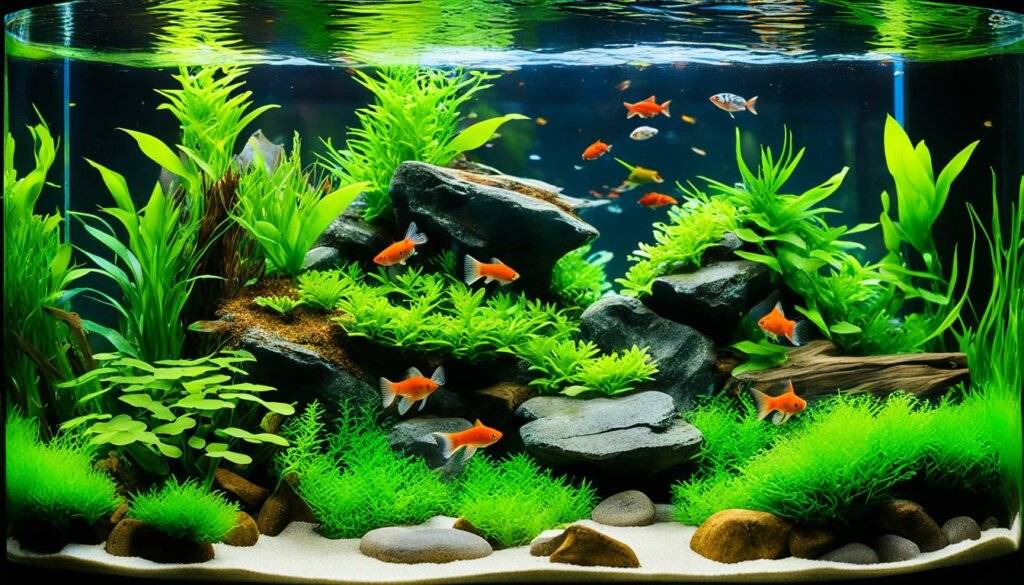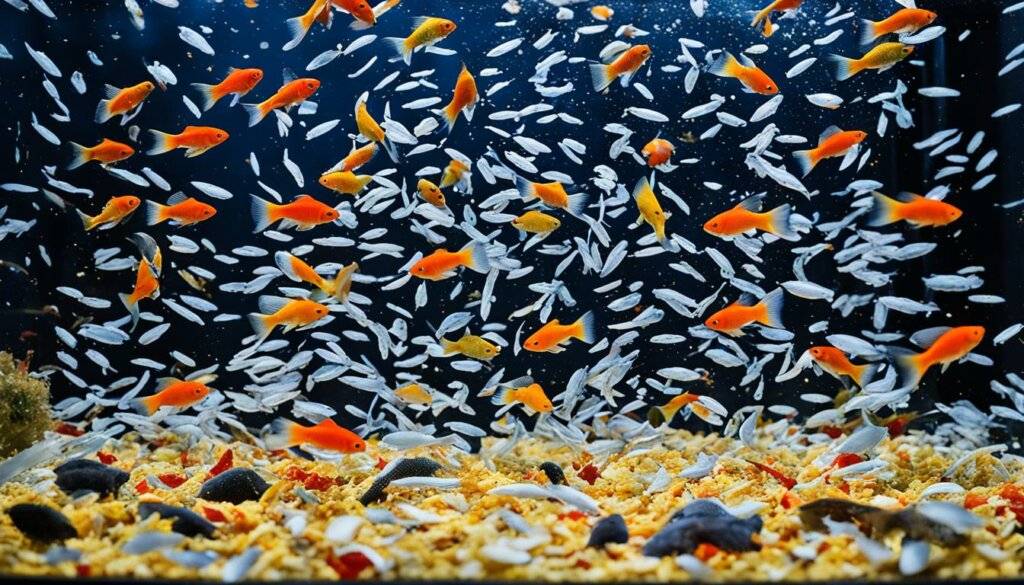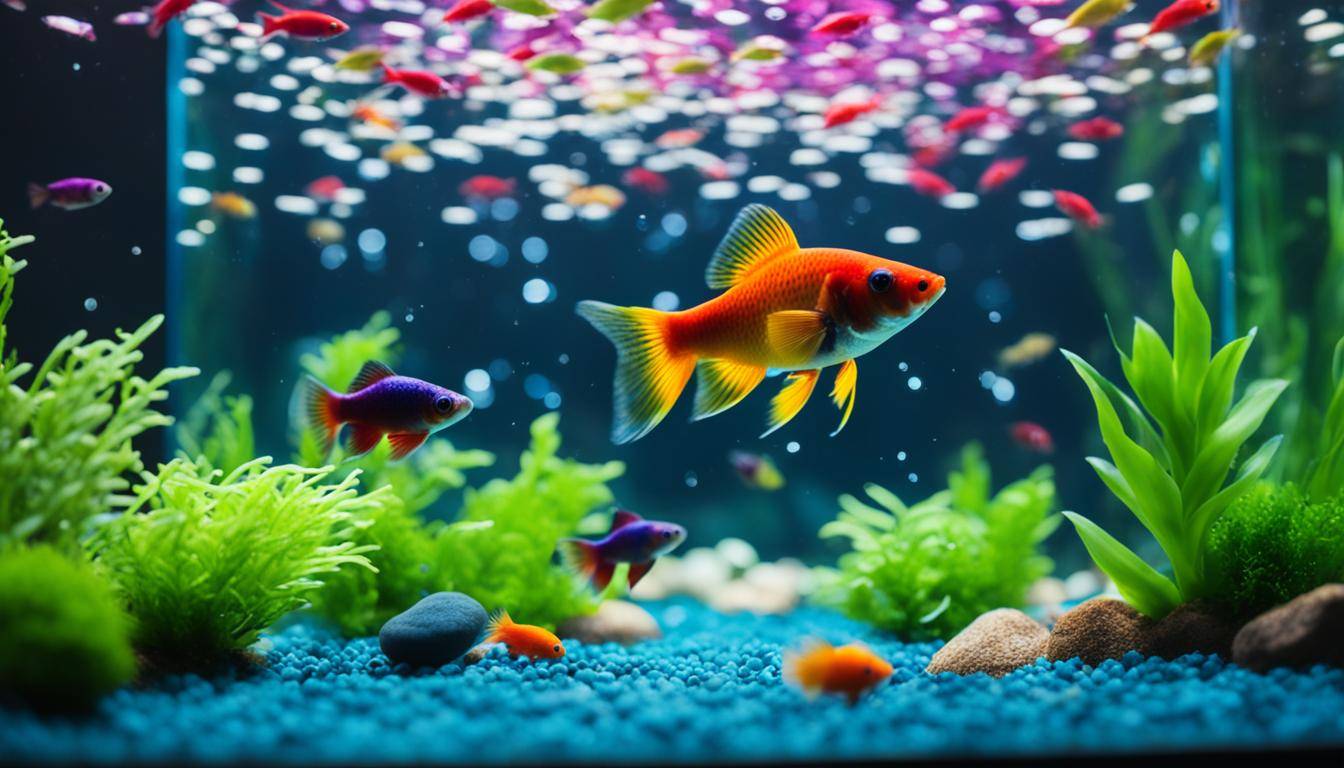Welcome to the beginner’s guide for platy fish care. If you’re new or somewhat experienced in fishkeeping, platies are a great choice. They are colorful, easy to look after, and come in many forms. We’ll give you key advice to ensure your fish are happy in a thriving aquarium environment.
Setting up the right tank for your platies is important. You need at least a 10-20 gallon aquarium for a small group. Make sure the water’s pH levels are right for them. Adding live plants will make the tank look better and provide hiding spots. It also helps keep the water clean.
It’s important to pick the right friends for your platies. They get along with other small, peaceful fish. Good choices include mollies, guppies, and tetras. But, always check if they’ll live happily together before you mix them in your tank.
Feeding your platy fish well is crucial for their health. They are omnivores and like a mix of food types. Offer them various high-quality flakes, pellets, and fresh foods. This keeps them healthy and lively.
If you’re thinking about breeding platies, it’s quite exciting. They are known to have lots of babies quickly. We’ll provide guidance on how to set up for breeding, understand their breeding habits, and how to look after the young ones.
With proper care, platy fish will make your aquarium bright and active. Discover more about platy fish care, breeding insights, and more below. You’re about to start a rewarding adventure with these stunning fish!
What are Platy Fish?
Platies are a favorite among freshwater aquarium enthusiasts. We see two main species, Xiphophorus maculatus (southern platyfish) and Xiphophorus variatus (variable platy). These fish can breed with each other and with swordtails, creating many color types. Mickey Mouse, sunburst, red wag, blue, bumblebee, and green lantern are some popular ones. They grow to 2-3 inches and live 3-4 years in a good tank.
Platies are known for their bright colors and active behavior. They fit well in tanks of all sizes. Their lifespan is short, but they fill your aquarium with life for several years. Whether you’re new or adding to your collection, discovering platies is exciting.
Setting up a Platy Fish Tank
Getting the right setup for your platy fish is key to their happiness. You should think about the tank size, water specifics, the filter, and how warm the water is. We’ll cover what you need to know so your platies do well.
Tank Size
A big enough tank is important for your fish’s health. Aim for a 10-20 gallon tank or even bigger for them. Bigger tanks mean more room to swim and better water conditions.
Water Parameters
Platies are tough and can handle different pH levels, from 6.8 to 8.5. They like harder water, so you might need to add minerals to soft tap water. Regular water checks are crucial for their well-being.
Filtration
Good filtration keeps the water clean for your platies. You can use any filter, like air pump ones or electric ones. Make sure it’s right for your tank size and cleans the water well.
Heating
Platies need a warm environment, between 70-82°F. Use a heater to keep the temperature steady, especially if your room is cool or changes a lot. This keeps your fish comfortable.
Thinking about tank size, water, filter, and heating will make a great home for your platies. Check the water often and adjust as needed to keep your fish happy and healthy.

-
Save
| Tank Size | Water Parameters | Filtration | Heating |
|---|---|---|---|
| 10-20 gallon or larger | pH: 6.8-8.5; slightly harder water recommended | Any type of aquarium filter | 70-82°F temperature range |
Feeding Platy Fish
Platies are omnivores who enjoy a variety of foods. To keep them healthy, they need a mix of different foods in their diet.
A good diet for platy fish includes:
- High-quality flakes
- Pellets
- Freeze-dried foods
- Frozen foods
These feeds give platies the proteins, veggies, algae, vitamins, and minerals they need to stay healthy.
Adult platies do well with just one meal a day. But young platies growing fast may need two to three smaller meals daily.
It’s important not to overfeed platies to avoid health problems. Finding long strings of poop in the tank means you’re feeding them too much. Platies can go without food for a bit, so missing a meal is okay. But if you’ll be away for a while, consider an automatic feeder or a pet sitter for them.
“A balanced diet is the key to ensuring the long-term health and well-being of your platies.”
Feed your platy fish well and on schedule, and they will show off their bright colors and playful behavior.

-
Save
| Platy Fish Feeding Guide | Details |
|---|---|
| Types of food | High-quality flakes, pellets, freeze-dried foods, frozen foods |
| Frequency | Adults: Once a day Juveniles: 2-3 small meals throughout the day |
| Signs of overfeeding | Long strings of poop in the water |
| Feeding while away | Automatic fish food feeder or pet sitter |
Conclusion
Keeping platy fish is very rewarding. Make sure their tank is right, feed them well, and choose friends for them carefully. These fish are tough, playful, and full of color.
These tips are for anyone with an aquarium. To keep your platy fish healthy, check the water’s pH and temperature. Don’t forget a good filter and heater too.
Feed platies different foods like flakes, pellets, and frozen stuff. But don’t feed them too much. Too much food means their poop gets long. Also, live plants in the tank are good. They keep the water clean and give fish places to hide.
With love and care, your platies will make your tank lively. They’re colorful and fun to watch. If you follow these tips, your aquarium will be a happy place for a long time.
